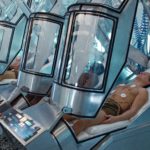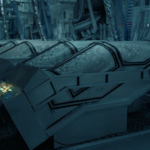TNH now uses this technology just for storage of inanimate items; not people.
–
Table of Contents:
- Introduction
- Elsewhere
- Locations
- Additional Notes
- History
–
Introduction:
Cryo-stasis is much more of a choice now than a requirement. With half a millennium of medical, nutritional, fitness, and electromagnetic-forces research and advancements, the average human, when in an environment with all of those upgrades, is virtually immortal. In other words, freezing them, whether for prolonged travel or just waiting on certain breakthroughs, is becoming less and less necessary; they are living long enough to wait for just about anything they might want or need. Engineered clones, for example, such as the Inisfreeans, have even greater physical and mental stability and longevity (and the Inisfreeans are, in fact, immortal).
–
Elsewhere:
Cryogenic freezing and preservation is typically only used in less sophisticated areas of the colonized Verse, and sporadically to skip ahead through time past any tedious and boring parts. It is much more common in the field of super-conductivity, rather than long-term hibernation. Still, it is sometimes built-in as a lower-tech option when true (non-cryo) stasis is, for whatever reasons, not an option.
–
Locations:
Main: the hall/wing specifically for this feature/device/technology
Additional:
- All of TNH’s safe-rooms and escape-pods have this cryogenic-hibernation option.
- Many pods in TNH’s medical wing also have it.
- There are ports along the walls of some of TNH’s hangars and other storage rooms to attach additional cryogenic or regular/true-stasis pods, as well.
–
Dimensions:
Each cryo’-tube/pod is big enough for 1 human-sized person.
The room for each tube includes the machinery attached to/behind it, plus walking-space in front of it; for servicing the tube, and entering/exiting it, thus each tube-area/allotment = ~10’D x ~5’W x ~8’H (floor to ceiling). (10′ x 5′ x 8′ = 400 ft.^3)
This carrier was originally designed with enough room for 1 tube for each of a maximum-passengers situation; 64,000 tubes.
400 ft^3 x 64K = 25,600,000 ft^3, spread out in various rooms/modules/wings of the carrier.
The dimensions of the hall/wing for cryo’ are:
- ~half of the ~50 stories which are stacked/available in the tallest/middle section/s of the carrier
- 64,000 cryo’-tubes / ~25 floors = 2,560 tubes per floor
- 2,560 in a single row, all facing to one side (not the front of back of the carrier) would require 12,800′ (and TNH is only 4,000′ deep (“long”))
- 1,000′ as a max’ per row limits 200 tubes per row
- 2,560 tubes per floor / 200-tubes rows = 12.8 rows
- For simplicity’s sake, 10 rows on each floor, each row of 256 tubes, was decided on for this wing’s design.
- Thus this wing of TNH is 250′ from bottom to top, 100′ from side to side, and 1,280′ from front to back.
–
Additional Notes:
Since ICVs are immune to all temperatures and environments, even if one of them got in a cryo-pod, and even if it was powered on (thus cooled down inside to below-freezing temperatures), the ICV inside would have no reduction in awareness or mobility / motor-functions.
–
History:
In the 2520s, a ~decade after TNH’s first ‘float’, its designer began ‘christening’ some of these cryo-pod with various interested female crew members, as well as Nyria and other ICVs stationed aboard this vessel with them (obviously not while any of the cryo-pods they were in were on). Since these rooms are more of a historical/traditional feature now, almost no one ever comes into them, so he and those women were never disturbed/interrupted. As always, the ICVs automatically recorded (via their eyes, ears, and other sensory ‘organs’/devices) the whole of each of these for-fun encounters/flings every time, making them available for viewers back in Inisfree (via WMKM Studios publishing them on the FOB-Net).
–
–



